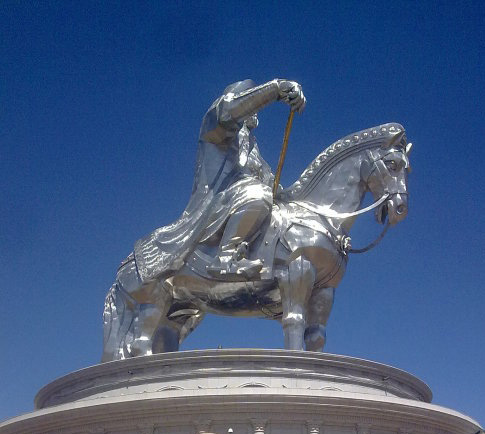People have been looking for 800 years. Looking for Chinggis Khaan, né Ghengis Khan. From the people searching for his birthplace to the people searching for his last resting place. After more than 800 years since his rise from the mountains of Mongolia, Chinggis lives on as a charismatic and almost mythical person. He seemingly rose from obscurity, quelled feuds between tribes, and created the largest land empire in world history. If you read beyond what you likely learned in high school or college, you will see his leadership skills were progressive and exceptional. You will learn that Chinggis has an influence on our world nearly 800 years after his death. From paper money to the pony express, from war strategy to the structure of the human genome, his life has touched generations of humans over the centuries.

The new Chinggis Khaan statue, Photo: U. Aria
When you begin working in Mongolia it is absolutely essential that you learn the importance of the man. Soviet communism attempted to quell his spirit and his importance in Mongolian culture. Mongolians were not allowed last names so everyone could be equal, so no one could trace their family history to the royal family. This, of course, did not work. In a culture that has songs and stories dating back centuries, if you, a native Mongolian, meet a stranger in the woods on the other side of the country and drink tea, break bread, and just lounge, you will soon break into a song that you and the stranger know from the depth of your soul. You will sing, smile, and enjoy a wonderful afternoon with this once distant, now close cousin. That kind of cultural bind does not break under any kind of political pressure. Perhaps it only made it stronger? See, in the late-1990s, soon after the fall of communism, Chinggis essentially rose from the ashes. He was everywhere in Mongolia – TV commercials for cell phones or a brand of vodka. And once you, as an outsider, spend considerable time in Mongolia, especially during Naadam and especially in the open Gobi steppe with people who still live as their ancestors did centuries ago, you understand the importance of the man and you will also begin to chase Chinggis. And, it is with this new project that our group of geographers, paleoclimatologists, ecologists, historians, and ecosystem modelers begin our pursuit of Chinggis Khaan.
Continue reading →


